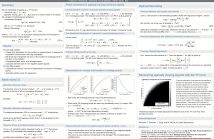- Read more about Super-resolution delay-Doppler estimation for sub-Nyquist radar via atomic norm minimization
- Log in to post comments
ICASSP2017.pdf
- Categories:
 36 Views
36 Views- Read more about Compressive Information Acquisition with Hardware Impairments and Constraints: A Case Study
- Log in to post comments
Compressive information acquisition is a natural approach for low-power hardware front ends, since most natural signals are sparse in some basis. Key design questions include the impact of hardware impairments (e.g., nonlinearities) and constraints (e.g., spatially localized computations) on the fidelity of information acquisition. Our goal in this paper is to obtain specific insights into such issues through modeling of a Large Area Electronics (LAE)-based image acquisition system.
- Categories:
 4 Views
4 Views- Read more about RECOVERY OF SPARSE SIGNALS VIA BRANCH AND BOUND LEAST-SQUARES
- Log in to post comments
BBLS2017.pdf
- Categories:
 14 Views
14 Views
- Read more about Compressed sensing and optimal denoising of monotone signals
- Log in to post comments
- Categories:
 4 Views
4 Views- Read more about Demixing Sparse Signals via Convex Optimization
- Log in to post comments
We consider demixing a pair of sparse signals in orthonormal basis via convex optimization. Theoretically, we characterize the condition under which the solution of the convex optimization problem correctly demixes the true signal components. In specific, we introduce the local subspace coherence to characterize how a basis vector is coherent with a signal subspace, and show that the convex optimization approach succeeds if the subspaces of the true signal components avoid high local subspace coherence.
- Categories:
 6 Views
6 Views- Read more about Energy Blowup for Truncated Stable LTI Systems
- Log in to post comments
In this paper we analyze the convergence behavior of a sampling based system approximation process, where the time variable is in the argument of the signal and not in the argument of the bandlimited impulse response. We consider the Paley-Wiener space $PW_\pi^2$ of bandlimited signals with finite energy and stable linear time-invariant (LTI) systems, and show that there are signals and systems such that the approximation process diverges in the $L^2$-norm, i.e., the norm of the signal space. We prove that the sets of signals and systems creating divergence are jointly spaceable, i.e., there exists an infinite dimensional closed subspace of $PW_\pi^2$ and an infinite dimensional closed subspace of the space of all stable LTI systems, such that the approximation process diverges for any non-zero pair of signal and system from these subspaces.
- Categories:
 14 Views
14 Views- Read more about Structure of the Set of Signals With Strong Divergence of the Shannon Sampling Series
- Log in to post comments
It is known that there exist signals in Paley-Wiener space $PW_\pi^1$ of bandlimited signals with absolutely integrable Fourier transform, for which the peak value of the Shannon sampling series diverges unboundedly. In this paper we analyze the structure of the set of signals which lead to strong divergence. Strong divergence is closely linked to the existence of adaptive methods. We prove that there exists an infinite dimensional closed subspace of $PW_\pi^1$, all signals of which, except the zero signal, lead to strong divergence of the peak value of the Shannon sampling series.
- Categories:
 9 Views
9 Views
- Read more about Rethinking Sketching as Sampling: Efficient Approximate Solution to Linear Inverse Problems
- Log in to post comments
Sampling and reconstruction of bandlimited graph signals have well-appreciated merits for dimensionality reduction, affordable storage, and online processing of streaming network data. However, these parsimonious signals are oftentimes encountered with high-dimensional linear inverse problems. Hence, interest shifts from reconstructing the signal itself towards instead approximating the input to a prescribed linear operator efficiently.
- Categories:
 6 Views
6 Views
- Read more about Sampling solutions of Schrödinger equations on combinatorial graphs
- Log in to post comments
We consider functions on a weighted combinatorial graph G (finite or countable) whose evolution in time −∞ < t < ∞ is governed by the Schro ̈dinger type equation ∂g(t, v)/∂t = i∆g(t, v), v ∈ V (G), with the combinatorial Laplace operator on the right side.
Global2016.pdf
- Categories:
 5 Views
5 Views